Tailor Made Combinations for Taekwondo Sparring Part 1
One of the most interesting aspects of Taekwondo training is putting together a combination of kicks and punches using some of our favourite techniques and more importantly ones that are tailor made for ourselves. We know from our earliest days which is our natural strong hand, and which leg we kick a football with. When we practise patterns some sequential techniques suit our body types and some may not flow so well. We all are aware of this because it is something we can immediately feel.
Over the next few months I will go through some of the most common combinations that will work for your sparring and I will outline some suggestions and explain methods of how to practise and drill each technique.
This months combination is Leading leg front kick, then two hand techniques, like a jab and a cross or a Ridge-Hand and then finish with a turning kick.
To start off, it is important to bear in mind the definition of combination is not just the kicks and the punches, but rather the position of the body and the relationship of the distance/range of each target as well. Distance training, and some conditioning work will all contribute to the effectiveness of the combination.
Even though we have not done so in the pictures (for clarity purposes), it is advisable to wear full sparring equipment when practicing these combinations.
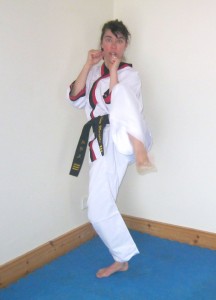 Front kick off the leading leg
Front kick off the leading leg
Pick up the chambering knee, as high as possible, and once the knee is about to reach the apex of the chamber you must slide in with the back leg, really fast and must be exactly at the same time, being careful to keep the contour of your body exactly the same prior to kicking to disguise your intention. (This aspect of disguising your intention, until the last possible minute, is paramount closing the gap successfully and also more so for short range techniques)
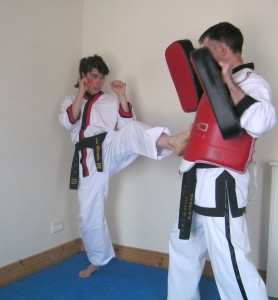
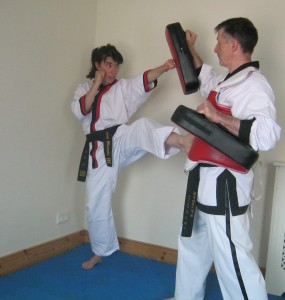 Leading Jab and Cross or
Leading Jab and Cross or 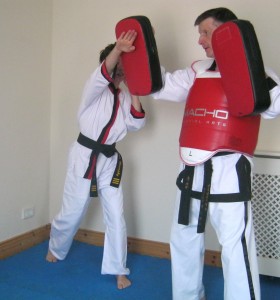 Ridgehand from the backhand.
Ridgehand from the backhand.
Once the front kick has landed, aim two punches towards the eyes of the opponent, so he/she is temporarily blinded, or at least will cause some reaction. The first is a leading jab and the second a cross, or a ridge-hand. This second hand technique must rapidly follow the first technique.
Turning Kick or Side Kick
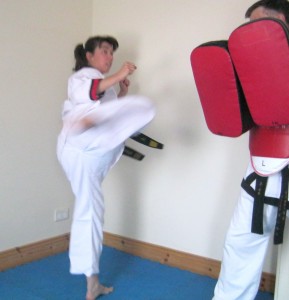 As your body turns and executes either a rear leg side kick or turning kick to complete a four technique combination. Simultaneously the body is turning and you are performing the jab ,cross and the final kick all in a flowing manner.
As your body turns and executes either a rear leg side kick or turning kick to complete a four technique combination. Simultaneously the body is turning and you are performing the jab ,cross and the final kick all in a flowing manner.
The best equipment for the pad-holder is two Thai pads and a body shield. Fire the front kick either to the body shield or the pads, but the body shield would be more realistic, and then the hand techniques to the pads and turning kick to the body shield to finish.
Finally some tips on putting a decent combination together:
1. Find your best side to launch/ chamber the leading kick or punch.What is of paramount importance is closing the gap between you and your opponent, and this can only be achieved successfully by disguising your intention until the last possible minute. I could write a book on this as it is one of the best secrets to closing the distance in all aspects of fighting. If you just look at the first photo where Catarina chambers the lead kicking leg, its no big deal, you all have seen this lead leg shot before. However, the second that knee is chambered the support leg quickly shuffles forward just 100mm or four inches approx but must be at the exact same time. Many times if you look carefully, you will see most folks shuffle the support leg BEFORE the knee is chambered, a dead give away, because the initial timing was off and you telegraph your intention way too soon, so you lose the surprise and fail to close the gap successfully. Now you can look at combinations all day and there are thousands out there. But folks, if that initial move is not disguised well, trained and honed over and over again, especially until the last possible milli-second, …Well…OK.. next…number two… Ha… Ha
2. Always lead from the front, like a leading Jab in Boxing, as it is much safer than a cross from the back hand. I would not recommend firing the first technique from the back or rear leg, as your opponent will see it coming and you may be turning your body into his/her attack. The only exception would be a jumping spinning side kick, from the rear leg, and the correct distance was in place, or was created if you were moving backwards yourself (I will elaborate more on this in another blog post).
3. Make sure it flows naturally. One of our legs is usually more flexible than the other, and one of our hands is faster or stronger than the other, so try and establish which suits your body best when you are tailor making and building up your own combination.
4. Building combinations can be specific to the end purpose in mind. Have one specific for Boxing or hand combinations (Short/Close range)where you wear proper protection for your hands. For self defense have a two or three practical strikes, like, palm strikes, (I wouldn’t recommend a punch for self defense, palm strike is best) elbows, and knees and low kicks.
5. Once you have tailor made and built up your combination, apart from using with your training partners and practising it sparring against different opponents, as repeated above, try and test it against the clock and see how many of your combinations you can perform in a minute or more.
6. Do not overload the amount of techniques. It would be ridiculous to have ten techniques. Perhaps 2 or 3 minimum and about 4 to 5 techniques would be about maximum.
7. Adapt your combination after initial testing. For example it may work well on the pads or air shields but is difficult to make it work in sparring, and with different opponents. Play around with it until your find it flows well.
8. Be disciplined. We all have certain training rituals/ habits. Some benefit us greatly, some sadly do not serve us so well. Have weight training combinations, warm up combinations, small mini callisthenic fitness training combination that you can use for a few months and change and adapt as you see fit.
These are just eight points, so try and stay congruent if you are putting other types of combinations together for yourself. As you get into putting your own combinations together, what happens is that you get more creative, and you can steer your creation towards either a practical or more artistic combinations that suit sparring, self defense or exhibitions. Having a strong reason WHY building your own designed combination is important to keeping your passion for training. As always I am asking for your continued feedback, and do let me know if this article was of benefit to your development and how your creations turn out, until next month enjoy every moment of your training.
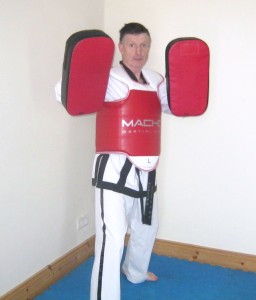 Master Frank Murphy 7th Dan has been practising Taekwon-Do since 1974, and conducts seminars internationally. He recently launched a book ‘Boxing Basics for Martial Arts’ , available in Amazon, which is ideal for Taekwondo practitioners who want to improve on their hand techniques.
Master Frank Murphy 7th Dan has been practising Taekwon-Do since 1974, and conducts seminars internationally. He recently launched a book ‘Boxing Basics for Martial Arts’ , available in Amazon, which is ideal for Taekwondo practitioners who want to improve on their hand techniques.




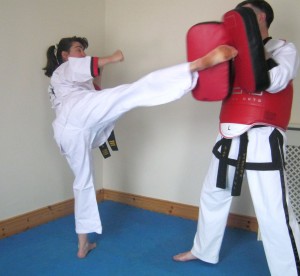

Hi Sir hope you are keeping well, many thanks to yourself and mamm for taking the time to put this excellant training aid together for all it is greatly appreciated
Respect and thank you
Kind Regards
Roy and Joanne Rowlands